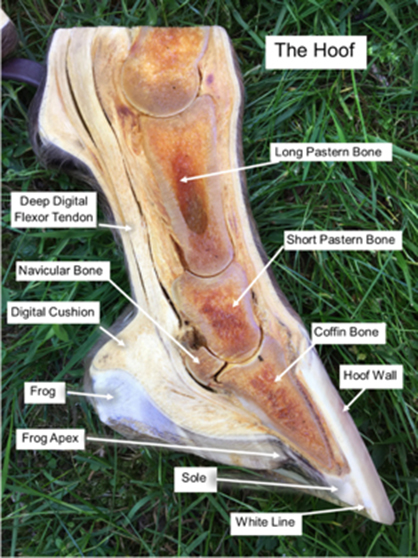Confusing Horse Hoof Anatomy Explained
If you have ever been confused about the structures and bones that are inside the horse’s hoof, you are not alone. For the average horse owner, a passionate study of this part of the horse’s anatomy can be discouraging. The reason is simple. It’s difficult to identify a framework when the names of their parts change.
Let’s start with the pedal bone—also called the coffin bone. It’s also called the distal phalanx, the os pedis, the P3 and the third phalanx. Conversations around this part of the internal hoof structure require adaptability. You must be able to change the label—like switching from one language to another. We horse-people must be adaptable.
This bone is farthest out from the body. I remember the word ‘distal’ by thinking of the word ‘distance’. And ‘phalanx’ is short for phalanges, which are the bones in the hands and feet of most primates. The P3 is one of four bones in the toe (if you will) of the horse. Its function is to serve as part of the team which enables shock absorption in the entire hoof during weight bearing and while in motion. It is meant to drop down, like a trampoline to accommodate the weight. For this to happen, the heels spread apart to provide space for the coffin bone and sole of the hoof to descend. Closest to the bottom of the foot, the function of this bone is affected by the treatment of the horse’s foot; whether or not to apply shoes and, ultimately, how to apply them.
Placed on top of P3, the second bone, is also called the middle phalanx, the P2 the os phalanx, the short pastern bone and the second phalanx. The P1 is above the P2. Makes sense, right? But wait. This one is also called the long pastern bone (because it is the longest), and it is also called the os compendale, os saffragenous and the first phalanx.
Attached by super-strength ligaments at the back of P2 and P3 is the all important albeit small, navicular bone or distal sesamoid, called the shuttle bone.
Made of elastic-like fibers and cartilage at the back of the hoof, is the digital cushion. Its function is to further assist with shock absorption and help pump blood to deliver oxygen and nutrients. As an extension of muscle tissue, the deep digital flexor tendon runs along behind the navicular bone and helps to further flex and extend the digit. Attached to the hoof wall and the coffin bone is an extensive supply of blood vessels that help nourish the hoof. This is called the corium or pododerm.
One of our biggest challenges we face is the confusion when our horses become lame. Comprehending the language spoken regarding the above components and their relative function in relation to each other will support your clarity in conversation with your veterinarian. This is our responsibility. With this basic information we can better accept and understand a diagnosis. For the most part, there is no need to be further versed in the intricacy of the inner hoof. Now however, with your greater understanding, you can be involved in the prognosis. There are options. If we intend to keep our horses sound, it is our responsibility to understand them. We are currently experiencing the biggest evolution in the treatment of horse feet in our lifetimes.
This is not to suggest that we take 100 percent of hoof treatment into our own hands. You must have the support of your trusted veterinarian. It’s also great to know the therapeutic uses of Cavallo Hoof Boots.
Visit https://www.cavallo-inc.com to learn about the full line of hoof boots. Want more info? Sign up here for our free newsletter: https://www.cavallo-inc.com/email-signup-AHP. Call (877) 818-0037 from the USA or Canada or call direct, (604) 740-0037.
About the Source:
Carole Herder is the author of the #1 International Bestseller, There Are No Horseshoes in Heaven. She has been involved in horse health since 1993. Her company, Cavallo Horse & Rider Inc., develops, manufactures and distributes horse products in 26 countries. Herder designed and developed Cavallo Hoof Boots and Total Comfort System Saddle Pads. She presents trainings around the world to teach the benefits of keeping horses in a natural state. Herder is an honored recipient of the Royal Bank of Canada Woman Entrepreneur of the Year Award. She is a member of the Women’s Presidents Organization, supporting female entrepreneurs in every industry.











